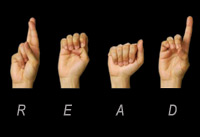Have you ever wondered how deaf people engage with the written word? It’s a fascinating topic that might have crossed your mind, yet you never had the chance to explore it.
You might be surprised by how intricate and varied the answers can be. Understanding the unique ways in which deaf individuals experience reading can open your eyes to new perspectives and deepen your appreciation for the diverse ways we all interact with language.
As you dive into this article, you’ll uncover insights that could shift your thinking and even spark a curiosity to learn more. Get ready to discover how reading and communication can transcend the boundaries of sound.

Credit: www.hearingdogs.org.uk
Silent Literacy Journey
Deaf people have a unique way of learning. They rely on their eyes to read and understand. Sign language is important. It helps them learn words and meanings. Visual cues make learning easier. Pictures and gestures are common tools. They aid in understanding concepts.
Reading for deaf people can be fun. Books with images are helpful. Stories come alive with pictures. Interaction with others boosts learning. Sharing ideas enhances their skills. Deaf readers often develop strong visual skills. This helps them grasp information quickly. Technology plays a vital role too. It offers accessible resources for learning.
Understanding Deaf Culture
Deaf culture is rich with language diversity. Many deaf people use sign language to communicate. Sign language is different from spoken languages. It uses hand shapes, facial expressions, and body movements. Each country has its own sign language. For example, American Sign Language is popular in the USA.
Sign language is very important in deaf culture. It helps deaf people express thoughts and feelings. It builds connections between deaf people. Many deaf children learn sign language from a young age. Schools teach sign language to help children learn better. Sign language is not just for deaf people. Hearing people can learn it too. This helps in understanding and communicating with the deaf community.
Reading Skills In Deaf Individuals
Deaf people often use visual learning to read. They look at images and signs. This helps them understand better. Visual cues support their learning. They can relate words with pictures. This makes reading easier and fun. Using colors and shapes can also help. It grabs their attention. It helps in remembering words.
Early education is very important. It helps in developing strong reading skills. Deaf children learn better with early support. They get used to reading techniques early. Schools and parents play a big role. They provide the right tools and environment. This helps children become good readers. Early education builds a strong foundation for future learning.

Credit: www.deaffriendly.com
Challenges In Literacy Acquisition
Deaf people often face limited access to learning materials. Many educational resources are designed for hearing individuals. This makes it hard for deaf learners to find suitable materials. Schools may lack specialized tools for deaf students. Libraries might not have books in sign language or with visual aids. Online resources can be scarce and not tailored for deaf users. This results in fewer opportunities to develop reading skills.
Communication challenges impact learning. Deaf individuals may struggle to understand spoken language. This affects their ability to grasp written words. Sign language is visual and different from spoken language. Translating ideas from sign language to text can be tricky. Teachers may not know sign language well. This creates a gap in teaching and learning. Peer interaction can also be limited, affecting social learning.
Innovative Educational Strategies
The bilingual-bicultural approach helps deaf people learn. They use two languages. One is sign language. The other is the written language. This method supports understanding and expression. Deaf people feel connected to both cultures. It respects their identity and language. This approach builds a strong language foundation. Children learn better this way.
Technology makes learning fun for deaf kids. Digital tools like tablets and apps help a lot. They use videos with captions and sign language. These tools teach reading and writing. Kids can learn at their own pace. It makes education more inclusive. Deaf children enjoy learning with these tools. It’s a big help for teachers too.
Success Stories
Deaf people often inspire others with their achievements. Some become famous writers. Their stories show that anyone can succeed. They prove that being deaf doesn’t stop dreams. Many deaf people work in arts and sports. They win awards and inspire millions. Their journeys teach us about strength and hope. They remind us that challenges can be overcome.
Many deaf people achieve high in education. Some earn degrees from top universities. They study hard and never give up. Their achievements show strong will and passion. Teachers and friends support them along the way. They often use sign language to learn. Technology helps them access more information. Their success proves that education is for everyone.
Future Prospects For Deaf Literacy
Policy changes can help improve reading for deaf people. New rules can make schools better for learning. Schools can use sign language more. Teachers can learn how to teach deaf kids better. These changes can make reading easier for everyone. Deaf people will get more chances to learn.
Community support initiatives are important for deaf literacy. Local groups can help deaf people learn to read. They can offer classes and workshops. Volunteers can read with deaf children. Libraries can have more books in sign language. Communities can work together to support deaf readers. Everyone can play a part in helping.

Credit: llcn.sdsu.edu
Frequently Asked Questions
Can Deaf People Understand Written Language?
Yes, deaf people can understand written language. They learn to read and write just like hearing individuals. However, their reading skills may vary. Some may excel, while others might face challenges. Deaf education methods and individual experiences play a significant role in their literacy development.
Do Deaf People Read Differently From Hearing People?
Deaf people may read differently due to their unique language experiences. They often rely on visual cues and context. Reading strategies might include using sign language structure. However, many deaf individuals achieve reading proficiency similar to hearing peers with effective education.
How Do Deaf People Learn To Read?
Deaf people learn to read through specialized education techniques. These include sign language, visual aids, and phonetic awareness. Teachers often use visual storytelling and context to enhance understanding. Early intervention and consistent practice significantly contribute to developing reading skills in deaf individuals.
What Challenges Do Deaf People Face When Reading?
Deaf people may face challenges in reading due to limited exposure to spoken language. Vocabulary development and syntax understanding can be difficult. Reading comprehension might require additional support, such as visual aids or contextual clues. Educational resources and tailored teaching methods can help overcome these challenges.
Conclusion
Deaf people can read just like anyone else. They often use sign language as a primary communication tool. Many also read and write fluently. Reading helps them access information. It connects them to the world. Their reading skills can vary, just like in hearing people.
Support and resources improve their reading abilities. Understanding and patience help in communication. Deaf culture is rich and diverse. Appreciating this diversity is important. It fosters inclusion and respect. Let’s embrace and support all forms of communication. Every step counts in creating an inclusive world.
